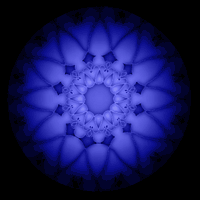Newton
In my last post, I mentioned something about Newton imposing his religious views on his science. This wasn't a rare or isolated event - scientists (or 'natural philosophers') felt they were uncovering the mind of 'God', and since they felt they already knew a lot about the mind of God, all that remained was to fit the scientific data into the religious framework. This happens in the present day as well... read up on the rapid acceptance of the Big Bang theory after the Vatican endorsed it as the scientific description of the creation of the world... the whole concept of peer review got thrown out the window since the data fit the religious framework so well.
Newton had some rather strong religious ideas, a belief in the necessary perfection of a universe that came into being through the actions of a necessarily perfect creator. Within the Judeo-Christian framework that Newton had to work with, there are some magic numbers, like '7', which represents perfection and fulfillment, via the creation myth. Newton wasted a lot of time trying to get the numerical components of his theories to fit in with the number 7... for instance, we might list the colors of the rainbow as
but Newton (who first formulated the theory of optics that accounted for the way white light could be split into a rainbow) would have listed 7 colors:
Now why the hell would he do that? The other 6 colors make sense... look at a color wheel, for instance, and you find a color's complement directly across from it on the circle. With 7 colors, this gets thrown out of whack. But in Newton's religious framework, the number 6 represented something unfinished, incomplete. (And if a single number 6 is bad, why then three of them in a row must be very very bad). There was no way Newton was going to release a theory whose primary modes numbered 6... so he created a seventh color and threw it into the list.
He wasn't the only one - most natural philosophers behaved the same way. For instance: most people know the (fahrenheit) temperature at which water freezes (32F), but many do not know the temperature at which water boils. Fortunately, the ancients encoded one of their beliefs into the system: freezing and boiling are diametrically opposed ideas, therefore if the continuum of temperature was represented on a circle, they should be shown to be at opposite sides of the circle. Since there are 360 degrees in a circle, points that are diametrically opposite will be 180 degrees apart. The boiling temperature of water must therefore be 180 degrees from the freezing temperature, or 32 + 180 = 212 degrees.
Newton had some rather strong religious ideas, a belief in the necessary perfection of a universe that came into being through the actions of a necessarily perfect creator. Within the Judeo-Christian framework that Newton had to work with, there are some magic numbers, like '7', which represents perfection and fulfillment, via the creation myth. Newton wasted a lot of time trying to get the numerical components of his theories to fit in with the number 7... for instance, we might list the colors of the rainbow as
- red
- orange
- yellow
- green
- blue
- purple
but Newton (who first formulated the theory of optics that accounted for the way white light could be split into a rainbow) would have listed 7 colors:
- red
- orange
- yellow
- green
- blue
- purple
- violet
Now why the hell would he do that? The other 6 colors make sense... look at a color wheel, for instance, and you find a color's complement directly across from it on the circle. With 7 colors, this gets thrown out of whack. But in Newton's religious framework, the number 6 represented something unfinished, incomplete. (And if a single number 6 is bad, why then three of them in a row must be very very bad). There was no way Newton was going to release a theory whose primary modes numbered 6... so he created a seventh color and threw it into the list.
He wasn't the only one - most natural philosophers behaved the same way. For instance: most people know the (fahrenheit) temperature at which water freezes (32F), but many do not know the temperature at which water boils. Fortunately, the ancients encoded one of their beliefs into the system: freezing and boiling are diametrically opposed ideas, therefore if the continuum of temperature was represented on a circle, they should be shown to be at opposite sides of the circle. Since there are 360 degrees in a circle, points that are diametrically opposite will be 180 degrees apart. The boiling temperature of water must therefore be 180 degrees from the freezing temperature, or 32 + 180 = 212 degrees.

0 Comments:
Post a Commentreturn to front page